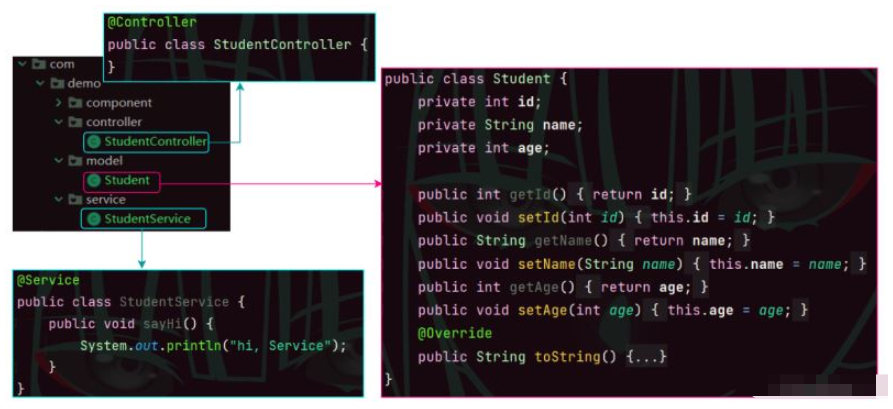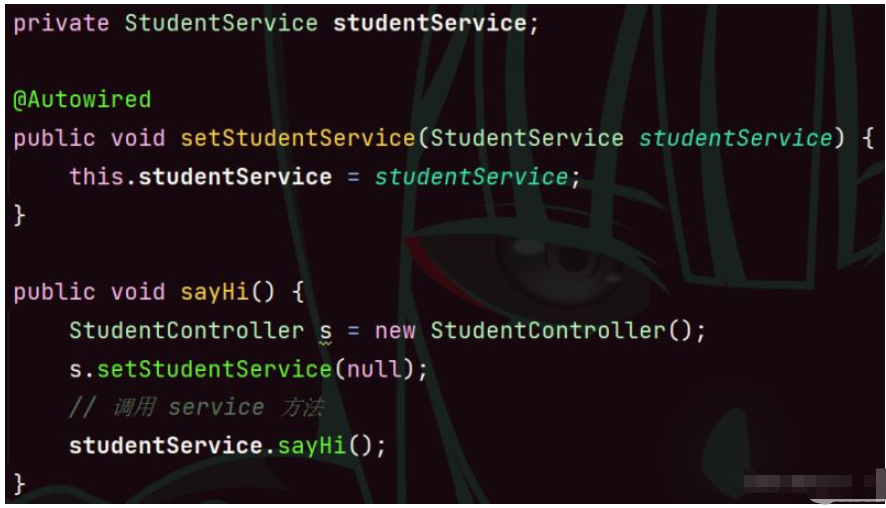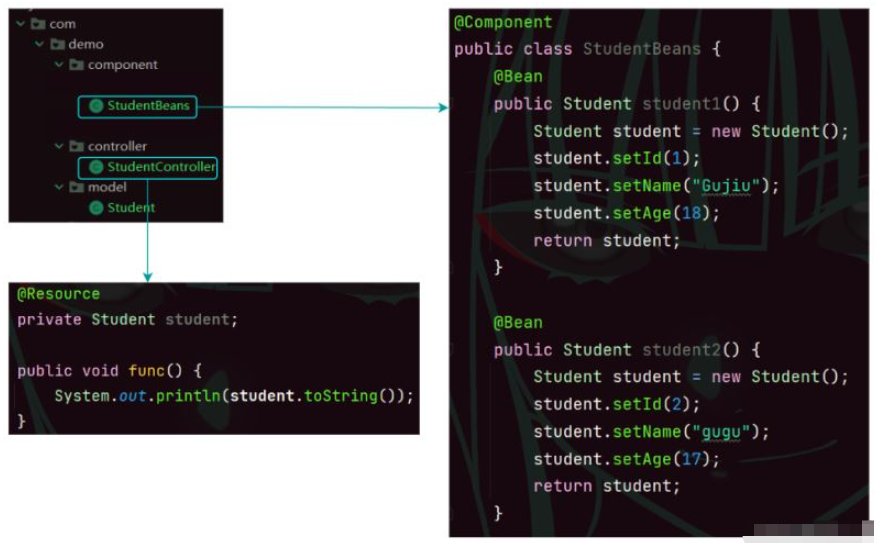这篇“Java之Spring简单读取和存储对象的方法是什么”文章的知识点大部分人都不太理解,所以小编给大家总结了以下内容,内容详细,步骤清晰,具有一定的借鉴价值,希望大家阅读完这篇文章能有所收获,下面我们一起来看看这篇“Java之Spring简单读取和存储对象的方法是什么”文章吧。
获取 bean 对象也叫做对象装配,是把对象取出来放到某个类中,有时候也叫对象注⼊。
对象装配(对象注入)的实现方法以下 3 种:
属性注入
构造方法注入
Setter 注入
我们先创建如下几个包和几个类:

属性注⼊是使⽤ @Autowired 实现的,将 Service 类注⼊到 Controller 类中.
@Controller
public class StudentController {
// 1.使用属性注入的方式获取 Bean
@Autowired
private StudentService studentService;
public void sayHi() {
// 调用 service 方法
studentService.sayHi();
}
}优点:
实现简单, 使用简单.
缺点:
功能性问题: 不能注入不可变 (final) 对象.

在 Java 中 final 对象(不可变)要么直接赋值,要么在构造方法中赋值,所以当使用属性注入 final 对象时,它不符合 Java 中 final 的使用规范,所以就不能注入成功了。
通用性问题: 只能适应于 IoC 容器.
设计原则问题: 更容易违背单一设计原则. (针对对象是类)
单一设计原则:
针对于类级别
针对于方法级别
从 Spring 4.x 之后, Spring 官方推荐使用构造方法注入的形式.
@Controller
public class StudentController {
// 2.构造方法注入
private StudentService studentService;
// @Autowired 可省略
@Autowired
public StudentController(StudentService studentService) {
this.studentService = studentService;
}
public void sayHi() {
// 调用 service 方法
studentService.sayHi();
}
}# 注意 #
@Autowired 可省略.
但是如果类中有多个构造⽅法,那么需要添加 @Autowired 来明确指定到底使⽤哪个构造⽅法,否则程序会报错.
优点:
可注入不可变对象.

注入对象不会被修改.
加了 final 修饰符.
构造方法是随着类加载只执行一次的.
注入对象会被完全初始化. (使用构造方法带来的优点)
通用性更好.
缺点:
没有属性注入实现简单.
Setter 注⼊和属性的 Setter ⽅法实现类似,只不过在设置 set ⽅法的时候需要加上 @Autowired 注解.
@Controller
public class StudentController {
// 3.setter 注入
private StudentService studentService;
@Autowired
public void setStudentService(StudentService studentService) {
this.studentService = studentService;
}
public void sayHi() {
// 调用 service 方法
studentService.sayHi();
}
}优点:
更加符合单一设计原则. (针对对象是方法级别)
缺点:
不能注入不可变对象 (final 修饰的对象).
注入的对象可被修改.
set 方法是普通 set 方法, 可以被重复调用, 有被修改的风险.

小结: 日常开发当中, 使用属性注入实现更简单的读取 Bean, 依然是主流的实现方式.
在进⾏类注⼊时,除了可以使⽤ @Autowired 关键字之外,我们还可以使⽤ @Resource 进⾏注⼊.
@Controller
public class StudentController {
@Resource
private StudentService studentService;
public void sayHi() {
// 调用 service 方法
studentService.sayHi();
}
}@Autowired 和 @Resource 的区别
相同点: 都是用来实现依赖注入的.
不同点:
功能支持不同: @Autowired 支持属性注入, setter 注入, 构造方法注入; @Resource 只支持属性注入和 setter 注入, 不支持构造方法注入.
出身不同: @Autowired 来自于 Spring 框架; 而 @Resource 来自于 JDK.
参数支持不同: @Resource 支持更多的参数设置; 而 @Autowired 只支持 required 参数.
当出现以下多个 Bean,返回同⼀对象类型时程序会报错

此时我们运行:
public class App {
public static void main(String[] args) {
ApplicationContext applicationContext =
new ClassPathXmlApplicationContext("spring-config.xml");
StudentController studentController =
applicationContext.getBean("studentController", StudentController.class);
studentController.func();
}
}# 注意 # 会报错, 报错的原因是,非唯一的 Bean 对象。
同⼀类型多个 Bean 报错处理
解决同⼀个类型,多个 Bean 的解决⽅案有以下两个:
使⽤ @Resource(name="student1") 定义.
使⽤ @Qualifier注解定义名称.
# 使⽤ @Resource(name="student1") 定义.
@Controller
public class StudentController {
@Resource(name = "student2")
private Student student;
public void func() {
System.out.println(student.toString());
}
}# 使⽤ @Qualifier 注解定义名称.
@Controller
public class StudentController {
@Resource
@Qualifier("student2")
private Student student;
public void func() {
System.out.println(student.toString());
}
}# 如果我们想用 @Autowired 可以写成:
@Autowired private Student student1; // 存在有耦合性问题
以上就是关于“Java之Spring简单读取和存储对象的方法是什么”这篇文章的内容,相信大家都有了一定的了解,希望小编分享的内容对大家有帮助,若想了解更多相关的知识内容,请关注亿速云行业资讯频道。
免责声明:本站发布的内容(图片、视频和文字)以原创、转载和分享为主,文章观点不代表本网站立场,如果涉及侵权请联系站长邮箱:is@yisu.com进行举报,并提供相关证据,一经查实,将立刻删除涉嫌侵权内容。